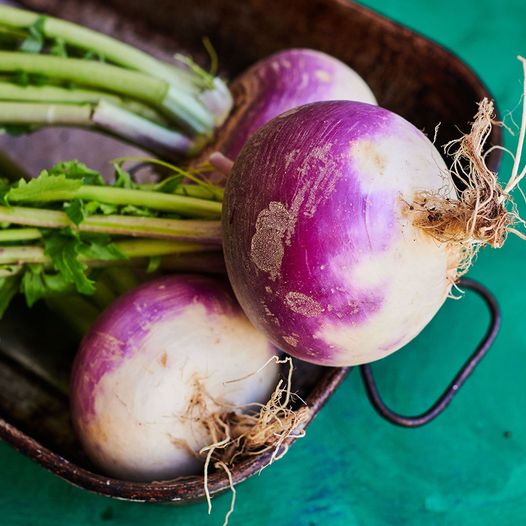How to Eat Turnips, Your New Favorite Root Vegetable
Turnips are often overlooked in the kitchen, but they’re a versatile and nutritious root vegetable that deserves more attention. Whether you’re using the bulbous root, baby turnips, or their leafy greens, turnips can be a delicious addition to many dishes. With a slightly spicy flavor that mellows when cooked, turnips are excellent for soups, stews, gratins, and side dishes, while turnip greens are a nutrient-packed green that can be sautéed or braised. Here’s how to buy, store, and cook them for maximum flavor and nutrition!
What Are Turnips?
Turnips are round, bulbous root vegetables that typically have purple tops and white bottoms, though colors can vary. While they may not be as colorful as other vegetables, they are incredibly nutritious and versatile.
Mature turnips have a stronger, spicier flavor that’s best cooked to mellow out the bitterness.
Baby turnips, which are harvested in the spring, are milder in flavor and can be enjoyed raw or lightly cooked. They often have a blushing pink or creamy white skin.
Turnip greens (the leafy tops) are nutrient-rich and can be used just like collard or mustard greens.
Turnips vs Rutabagas
Turnips are often confused with rutabagas. While both are in the brassica family, the key difference is in their flavor:
Turnips are more spicy and bitter when raw, but mild and nutty when cooked.
Rutabagas are sweeter and less bitter, making them a more subtle option for many dishes.
Nutritional Benefits
Turnips are part of the cruciferous vegetable family (like broccoli and cabbage) and are rich in:
Vitamin C: Helps boost immunity and skin health.
Vitamin A: Important for vision and skin health.
Folate: Supports cell division and growth.
Calcium and Potassium: Important for bone health and muscle function.
Antioxidants: Help fight inflammation and oxidative stress.
How to Buy and Store Turnips
Look for Freshness: When buying turnips, try to select those that are firm and heavy for their size. The smaller the turnip, the milder its flavor. If you can find turnips with the greens still attached, that’s a bonus!
Storage:
Roots: Store turnips in the fridge in a perforated plastic bag for up to 2 weeks.
Greens: Turnip greens can be stored in the fridge in a damp paper towel in a plastic bag for up to a few days. Rinse them just before use to remove dirt and grit.
Washing: To clean turnip greens, swish them in cool water, wait a few minutes, and repeat to remove any dirt. Pat dry before cooking.
How to Cook Turnips
see next Page
How to Cook Turnips
Turnips can be prepared in a variety of ways. Use them as a substitute for potatoes or carrots in many recipes, or enjoy their unique flavor on their own.
1. Soups, Stews, and Braises
Turnips are great in hearty soups and stews. Their firm texture holds up well during long cooking times, making them perfect for slow-cooked dishes. Try adding turnips to your favorite recipes like:
Vegetable Soup: Turnips add a mild sweetness to a classic vegetable soup.
Pot Roast: Turnips can be added to the pot with other root vegetables for a comforting meal.
Navarin of Lamb: A French stew that’s perfect for a hearty winter meal.
2. Side Dishes
Turnips can be prepared just like potatoes—mashed, roasted, or gratinéed. Keep in mind they have more water and less starch, so they won’t be as fluffy as potatoes but are still delicious!
Mashed Turnips: Mash turnips with butter, cream, and a bit of salt for a light, flavorful side dish.
Roasted Turnips: Toss with olive oil, salt, and your favorite herbs, then roast until golden and tender.
Turnip Gratin: Layer thinly sliced turnips with cream, garlic, and cheese, then bake until bubbly and golden.
Continued on next page
